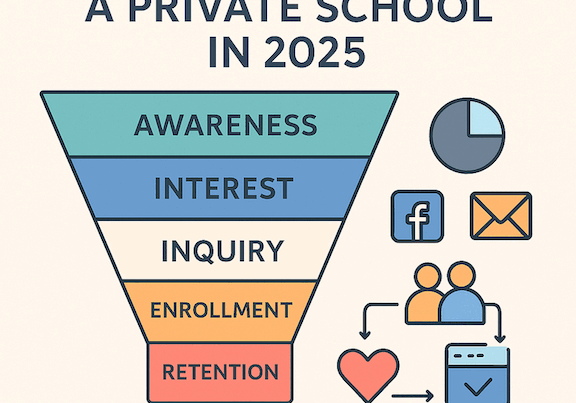
Large numbers of marketers have a swath of skills that could impress anyone until they analyze the results. For instance, if a marketer creates a comprehensive and beautiful online presence for a school, but there’s no traffic or conversions for enrollment, the marketer is failing. Professional marketers understand the importance of a target audience in marketing and establish that aspect before they attempt anything else.
Without a target audience, your school is speaking to an empty room. You may believe that your audience is all people, but there’s nothing further from the truth. In fact, there’s no quicker way to market to no one than to attempt marketing to everyone.
In conclusion, it’s essential to identify your target audience in order to build a winning strategy. For guidance on finding a target audience for your school’s marketing strategy, we’ve put together this brief yet informative guide.
The Importance of a Target Audience in Marketing
In simple terms, target audiences are a specific group of people to which a marketer wishes to speak directly about an organization’s services. Without a target audience, a marketer is sending information about services out into the world of over 7.6 billion people. We’re confident that a school isn’t expansive enough to fit billions of people, so we recommend narrowing the audience substantially.
Why narrow down your audience? Why not send out information and let those who are interested find the school?
To answer a question with a question, why market your school at all?
Even if a school was large enough to fit billions of people, we’re certain that not all 7.6 billion people would be interested in what it offers. Further, prospective families won’t be motivated to research the school due to a lack of clarity about how the school could uniquely benefit them.
Prospects respond best when they feel special and uniquely targeted. Students and parents aren’t researching schools without regard for their needs. In contrast, they’re looking for the best possible school for their unique situation and desires.
Not to mention, you’ll save money on marketing by creating targeted and effective organic and PPC campaigns for fewer people with excellent results.
If you’re looking to stand out and convince prospective families that your school is the best choice, tailor your arguments for them. Namely, you’ll need to identify your school’s unique selling points and which types of prospective families would likely be interested in them. After, you’ll need to create marketing campaigns that specifically target those families.
How to Find Your School’s Target Audience
Begin the search for the target audience by identifying the services that the school offers. A school indeed differs from other organizations by providing educational services, but that’s not specific enough to build an effective target marketing campaign.
Dive deeper into what sets the organization apart from others beyond being an educational institution. List the unique programs and offerings that the school provides and take note of the families that are currently enrolled. Ask yourself what an interested prospective family would look like for the institution.
Geographic Location
One way to narrow down the audience is to think about the school’s location in comparison to other schools. Utilizing geographic keywords and tags in marketing campaigns is a powerful way to target a very specific audience with a high chance of success.
Marketing to families in other states won’t serve the purpose of the marketing campaign. Prospective families looking for schools will most likely want to stay close to home. Write out a list of neighborhoods, zip codes, and regions that would most likely enroll in the institution.
Utilize this list to improve SEO on the school’s website and social media pages. Not only will search engines prioritize your brand for the audience in your area, but prospective families will know immediately whether you are a viable option for their location.
Audience Demographics
In addition, marketers should identify the demographics that the school serves best. Demographics are often influenced by geographic location, but they are also informed by the types of services you offer.
For example, does the institution offer education for younger or older children? Does the community mainly consist of one race, or does it have a diverse mix of ethnicities? Do most of the parents have a bachelor’s degree or higher?
Knowing exactly what demographics the institution serves will help inform a targeted marketing strategy where the audience feels understood. Demographics will also help you choose the best channels to reach your audience, such as millennials who use Instagram.
Psychographics
Race, ethnicity, age, and location are all effective ways to start knowing your audience. In order to create a successful campaign, however, you must work even harder. Psychographics touch on common belief systems, values, personalities, and lifestyles within the brand’s perfect audience.
In marketing, psychographics help craft messages that speaks to what your audience finds most important. By understanding the niche audience’s lifestyle choices, for instance, you can offer tailored messaging about the services you provide that solve their pain points. Further, if you know the target audience’s values, you can create copy that shows how the institution’s values align with their own.
As an example, does a majority of the institution’s enrollees have parents who work late? As a solution, the school might offer stellar after-school programs for children whose parents can’t watch them until dinner time. In your marketing campaign, mention that the school runs programs past the last bell.
In addition, if the psychographics of a school includes parents who believe in strict discipline, the school could craft messaging that emphasizes that value.
Creating an Avatar
After you’ve created a list of identifiers, following the guidance of geographics, demographics, and psychographics, begin creating an avatar. In other words, form a figurehead that embodies what your target audience looks like. As a result, you’ll be able to better understand your target audience and formulate a personalized marketing strategy for them.
An avatar for a school could be James Nelson, a fourteen-year-old boy who is starting to become very interested in football. His father used to be a football star in college and raised him to be athletic. James, however, also loves history and doesn’t want to sacrifice his academics for sports.
Being the marketing professional for an institution in James’ area means crafting messages and content that highlights the school’s premier football program. At the same time, it means emphasizing that all athletes are expected to keep stellar grades and attendance.
Remember that schools must capture students’ attention first and excite them so that they pass on the content to their parents. For example, video marketing campaigns could highlight the action and excitement of the institution’s football team combined with interviews with teachers and coaches.
Market Directly to Your Niche
Finding your target audience can be difficult and time-consuming at first, but the effort will pay off later in both time and money saved. Knowing the importance of a target audience in marketing will help you create better marketing campaigns with impressive results.
VujaDay proudly helps schools create a solid digital presence and improve their marketing tactics. We specialize in content marketing, SEO, web design, and more so that you can improve enrollment and retention.
Let’s build something together. Contact us today!



